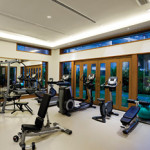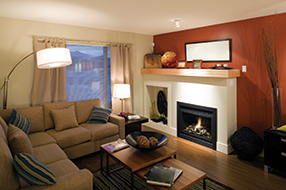The Amenities Factor
 Remember when the basic requirements for renting an apartment were simple: clean, affordable and safe? Today, modern renters don’t just want a place to live; they want it all—plus a few extras. In just about every major city in America, multifamily rental units are starting to resemble vacation destinations. In New York City, for example, certain rental buildings boast amenities like spa facilities, rock-climbing walls and lobby restaurants. Of course, such over-the-top accommodations demand hefty rents, but some features once thought of as high-end are becoming standard items that renters are expecting or, in some cases, are willing to pay extra for as part of their lease agreement.
Remember when the basic requirements for renting an apartment were simple: clean, affordable and safe? Today, modern renters don’t just want a place to live; they want it all—plus a few extras. In just about every major city in America, multifamily rental units are starting to resemble vacation destinations. In New York City, for example, certain rental buildings boast amenities like spa facilities, rock-climbing walls and lobby restaurants. Of course, such over-the-top accommodations demand hefty rents, but some features once thought of as high-end are becoming standard items that renters are expecting or, in some cases, are willing to pay extra for as part of their lease agreement.
ROOM WITH A LIFESTYLE
Whether an apartment is located in suburbia or the heart of an urban center, renters are looking for a menu-rich lifestyle, not just a place to park their belongings. “The multifamily rental-housing industry has definitely taken its cue from the hospitality industry,” according to David Senden, a principal with KTGY Group, Inc., Architecture + Planning, a residential and mixed-use architecture and design firm based in California. “Renters want to feel like they are living on vacation.”
People of all ages rent apartments but the bulk of tenants seeking that resort-style atmosphere are young professionals and Generation Ys, or millennials. And to attract the largest segment of renters in the country, apartment complexes are engaging in an ‘amenities war,’ says Senden, to lure prospective residents to their properties with specific features that resonate with renters’ unique living habits.
FITNESS FIRST
Americans love to work out—and millenials make it a priority to sweat and burn calories. And, if it is appealing enough, they will work out at the property fitness facility to streamline their schedules and reduce expenses. Fitness centers rank as the No. 1 common-area amenity preference among 83% of apartment dwellers, according to J Turner Research’s 2011 Evolving Resident Demographics report. Though work-out facilities are the norm in most apartment complexes, the look and feel of the rental exercise room has evolved from a cramped, poorly lit design afterthought to a bright space, painted in the latest color trends, that rivals any expansive monthly gym membership facility.
“The traditional gym doesn’t fly anymore,” explains Senden. “It has to include state-of-the-art equipment and be big enough that if they are working out with others they don’t feel crowded, with enough features that they can get rid of their monthly gym dues.”
GREEN IS A (FREE) GIVEN
In a 2012 For Rent Media Solutions survey, recycling programs were ranked as the No. 1 amenity renters seek in apartment living. It’s no surprise then that rental communities are tuning into renters’ eco-conscious mentality, promoting any LEED certifications, the use of low- or zero-VOC paint, and offering environmentally friendly features such as energy-efficient appliances, low-flow showerheads, and even electric car charging hookups.
Yet, while many properties have embraced some component of ecological and sustainable design, it’s more a renter expectation than an amenity selling point. “It’s nice to tout it, and residents will take it and are pleased with it, but they are not willing to pay a premium for being green,” says Alan Dibartolomeo, chief development officer at American Multifamily, an urban infill developer and builder located in Southern California.
Senden agrees. Rather than viewed as a perk, green-minded touches only add value in that renters assume the characteristics are a given in the base price of a rental. “Sustainability is appreciated and it carries some weight, but if being green affects the rent price then it doesn’t matter. It’s more of something that builders and designers have to do to keep up in the marketplace,” he adds.
In fact, at the 2013 Crittenden Multifamily Conference, a millennial panel moderated by Property Management Insider agreed that green, as an amenity, is overrated but essential for an apartment community.
TRADING SPACES
At one time, lavish floor plans topped the list of unwavering amenity demands in the rental world. But as of 2013, the average apartment size was 982 square feet, according to Multifamily Executive magazine. Turns out the less-is-more floor plan suits the needs of millennials who prefer premium common spaces rather than expansive living quarters, says Dibartolomeo. “Millennials don’t have as much furniture as previous generations and tend not to entertain in their units.”
Instead of distinct computer rooms, media centers, game rooms and lounges, apartment designers have combined those spaces into open-concept areas where tenants can mix and mingle. Interactive lobbies with a ‘town square’ layout offer full entertaining kitchens next to swimming pools, community gardens, and more reception and event spaces for tenants to host gatherings. “The trend is for smaller apartments but larger, comfortable social-gathering spots for renters to hang out. It’s a movement that focuses on fun and activities, with spaces that can range from game rooms to workshops for bikes and crafts,” Dibartolomeo explains. “People don’t stop living their lives because they rent.”
Senden agrees that providing opportunities for residents to interact outside of their rental unit is an amenity-win for properties: “Millennials are social creatures and tend to want lower rents, which has led to unit sizes shrinking. In exchange for the diminished living space, you have to provide other gathering places.”
As part of the trend to accommodate the social nature of modern-day renters, apartment properties are also retooling formerly neglected square footage into amenity-rich shared living. At one of American Multifamily’s properties in Glendale, California an entire roof was transformed into a sky deck, dedicated to being an outdoor entertaining space complete with multiple seating areas, cabanas, fire pits, barbecues, a media center, and a 12′ x 30′ projection wall where movies can be shown at night.
SPECIAL INTERESTS AMENITIES
It’s not all about what millennials want, though. Amenities are driven by diverse resident demographics and location. If it’s an urban infill area, proximity to mass transit, restaurants, supermarkets and nightclubs are important, according to Senden. In other cases, apartment communities have to provide amenities that adapt to the unique needs of its target residents. For example, KTGY built a community auto garage at one of its rental properties in Southern California where the all-senior resident population, most of who have downsized, can tinker and work on their cars. “From the building and property management end, you have to find a niche—an amenity that someone else doesn’t have,” explains Senden. Renters who live in student housing also demand unique amenities in their spaces, which are moving away from the cookie-cutter dorm facility to well-appointed complexes that include coffee shops, cyber lounges and game rooms. Tanning beds are a high priority in residential campus complexes too—it’s a feature included in a student housing project built by KTGY near San Diego University.
RENTER’S BEST FRIEND
If your apartment complex doesn’t allow pets, you might want to rethink your anti-Fido policy. According to a 2013 Apartments.com survey, 75% of renters had a pet. Driving that trend among younger renters was a push-back on milestone events like getting married and having children. So while millennials might not have much furniture or any kids, they own cats, dogs, birds and other furry and feathered friends. “Pets are considered their family,” Dibartolomeo says.
And renters won’t bark at extra charges related to living with their beloved furry ‘relatives.’ In the same survey, 63% of participants said they would pay a pet deposit and additional fees for their animals. “Pets are nonnegotiable,” Senden says. “Renters are willing to pay for anything that makes pet ownership convenient.”
Apartment management is taking note of the nation’s love of pets. From 2012 to 2013, properties that allowed pets increased from 59% to 78%. Not only are rental communities putting the welcome mat out for domestic animals, they are responding with less-rigid pet policies and a menagerie of pet-friendly services such as dog walks, runs, and washing stations, or at least proximity to pet facilities, so renters are more inclined to sign a lease.
WIRED TO THE WORLD
Since many young renters are multiple-device owners—smartphones, tablets, laptops and other mobile electronics—they seek out properties that enable them to get connected quickly. Most probably won’t care about landline capabilities but a tech-loaded apartment with high-speed Internet and access to Wi-Fi throughout the property will appeal to this digital rental audience who touches, swipes and clicks their way through daily tasks. Some properties even provide docking stations in units and tech support as part of the standard lease agreement. It doesn’t stop there, as tech accoutrements in multifamily housing are being enhanced across the board, according to Dibartolomeo. “Better security systems and integrated electronic communications, such as the ability to receive mobile messages when packages arrive and time-sensitive information like electronic lease renewal reminders are all gaining popularity. Increased services from the property management staff are now more like concierge-level amenities. Rents that we charge demand this level of service,” he says.
ONE RENT PRICE, LOTS OF STORAGE
Not surprisingly, when asked what was the most important amenity among three choices given in the 2012 For Rent Media Solutions survey, respondents listed all-inclusive rent as the No. 1 feature, followed by in-unit laundry and stainless steel appliances.
While the ability to bundle monthly rental expenses is important, parking and storage is always a concern. Though reserved parking is often included in the monthly rent fee, tenants still put a price tag on the feature and will pay extra for garage facilities and additional areas to house their bicycles and surplus possessions.
“Parking is expected in most places, with one parking space allocated per unit, unless it’s a congested urban location,” says Senden. “Storage, though, is a premium, especially for those who are past their 20s—they accumulate things living in small spaces. It’s not unusual for them to rent separate garages and storage spaces at $15 to $100 per month, depending on the space, which may include individual lockers or larger spaces for bulky items.”
Apartment amenity trends come and go but Senden believes consideration for external spaces is a different priority since interior spaces are ever-changing and flexible. “We have to be careful to create external design features that are not so specific that we can’t adapt.”
 COLOR TENANTS HAPPY
COLOR TENANTS HAPPY
Not quite ready to invest in a dog park or luxury Wi-Fi lounge? No worries. For less than the cost of a gallon of paint, you can make—and keep—tenants happy. Simply offering the opportunity to have an accent wall customized with a color of their choosing will make tenants feel catered to and more at home. Whether you offer a limited range of color options or turn tenants loose with a fan deck, the final results will color them happy.




